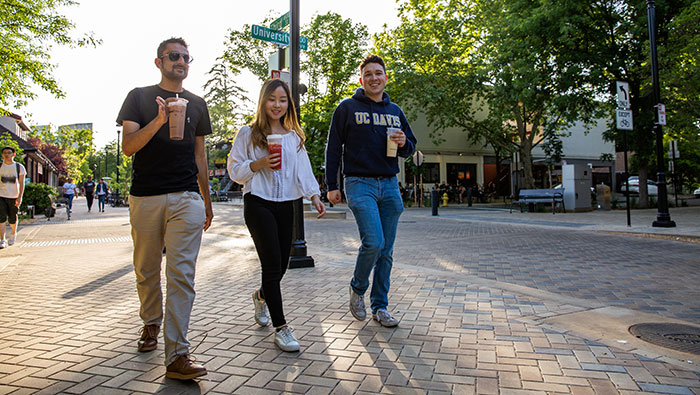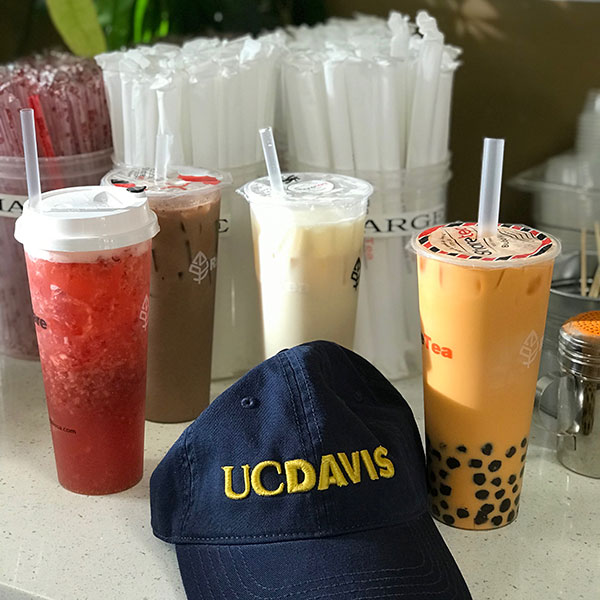
Bubble tea is a big deal in Davis.
At current count, 16 businesses serve the drink, also known as boba, in Davis, including Dining Services’ eateries on campus. (Don’t know boba? See sidebar)
Part of the drink’s rise in popularity — four new shops opened in Davis this past year alone — can be attributed to its customizability. On top of the black, green, oolong, and thai teas commonly served, ice levels, flavors, sugar levels, and toppings, which range from jellies to puddings to boba, can all be adjusted.
Customizability is part of why Kimi Villaroman ’19 enjoyed going to The Old Teahouse during her time at UC Davis. “There, I can ask for more tea rather than adding more milk,” she said.
And The Old Teahouse is a Davis favorite for Rosa Trieu ’09 — it was the only game in town when she went to UC Davis. “I lived in the apartment complex behind the tea shop so I was there all the time,” said Trieu. “I'm pretty sure there were days [when] I would get milk tea twice a day.”
But love for boba hasn’t always extended to boba shops, especially as places to study. “Coffee shops feel a lot more chill than boba places,” said third-year psychology major Arianna Oliveira. “They’re usually a place where people go to get work done.” That statement is echoed by Singh. “Coffee shops [are] typically quieter. Plus, there’s the environment of people studying,” she said.

Still, current students said they see boba shops as fun places to hang out, especially because many have diversified their menus beyond regular boba.
Lazi Cow, a shop in downtown Davis, serves alcoholic boba. MandRo and OnTap both serve a Korean dessert, bingsoo, that has shaved ice, condensed milk, and sweet toppings. The second-newest store to open in Davis, I-Tea, across from campus on A Street, offers a comprehensive snack and meal menu including ramen, takoyaki, and rice dishes.
In addition to food, said Jaime Barrairo, a fifth-year Asian American studies and cinema and digital media double major, boba shops tend to have board games.
As a result, they can offer a break from studying.
For many, boba — not coffee — reminds them of home. Saira Singh, a fourth-year biological sciences major, said her favorite boba shop is OnTap because it reminds her of Pekoe, a boba shop in her hometown, San Jose. Trieu, who grew up in Southern California, said that boba brings back memories.
“When I drink boba, I think of my hometown in the 626 in southern California,” she said. “I think of sitting at a small table catching up with friends, and/or working on my laptop with a friend. It always feels pleasant and nostalgic.”
The Scoop on Boba
No matter what you call it — boba, bubble tea, pearl milk tea — the terms generally refer to a chunky beverage consisting of tea (usually), milk, ice and chewy tapioca pearls. Sometimes it can be a fruit juice drink with gummy bits. Created in the late 1980s, boba is a takeaway from Taiwan’s culture of street food. As a result, most major boba chains in the United States, including T4 and Gong Cha, both located in Davis, originate in Taiwan; the exception is Boba Guys, started in San Francisco. “It's really interesting to see the different trends, too,” said Rosa Trieu ’09, who wrote about the boba craze for Forbes in 2014 and is now a technical writer for Vineti, a cell and gene therapy software and analytics company. “It started with boba, then mini boba, honey boba, and more recently, salted foam, cheese foam, and in-house made boba.” Though the exact origins of the drink are hard to pin down, the name boba is a reference to 1980s Hong Kong sex symbol Amy Yip.